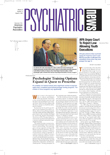Acomprehensive algorithm for the use of antidepressant medications appears to help physicians improve outcomes over “treatment as usual” for patients with severe major depression.
The Texas Medication Algorithm Project (TMAP) set out to provide a vehicle for more uniform treatment of mentally ill patients in Texas. The project, begun in 1997, was a collaborative effort by the University of Texas (UT) Southwestern Medical Center at Dallas and the Texas Department of Mental Health and Mental Retardation.
“TMAP is a disease-management program that includes algorithms and other support systems that help physicians make treatment decisions based on a patient's clinical status, history, symptoms, and results up to a specific point,” said Madhukar Trivedi, M.D., an associate professor of psychiatry and head of the depression and anxiety disorders program at UT Southwestern.
The original goal of unifying patient care across the state appears to have been rewarded with improved outcomes for patients as well.
Trivedi and his colleagues reported in the July
Archives of General Psychiatry that use of the TMAP depression guideline is associated with a two- to three-fold greater improvement in patients with depression compared with usual care. The research was funded by numerous sources (see
box at right).
“This study, which is the first to show the effectiveness of the TMAP on depression, is powerful and compelling,” Trivedi said.
Trivedi and his colleagues followed 547 patients with major depressive disorder at 14 clinics for a minimum of 12 months of treatment. At four of the clinics, patients received algorithm-based care, while the other clinics treated patients according to the clinic physician's usual-care plans. Patients in both groups had on-site clinical support from clinical coordinators and went through an education program for patients and families.
“Both groups of patients received treatment from qualified physicians who had access to the same treatments and medications,” Trivedi said.“ Therefore, all patients improved. But the level of improvement in the disease-management group was twice as much when measured by a clinician, and three times more improved when the patient described his or her own level of improvement. The outcomes for symptomatic improvement, as well as functional improvement, were dramatically better among patients who followed the algorithm-based program.”
Patients were rated on two primary outcomes: symptoms as measured by the 30-item Inventory of Depressive Symptomatology–Clinician Rated Scale (IDS-C) and function measured by the Mental Health Summary Score of the Medical Outcomes Study 12-item Short-Form Health Survey (SF-12). In addition, a secondary measure of improvement was the 30-Item Inventory of Depressive Symptomatology–Self Report Scale (IDS-SR).
Both patient groups saw significant reductions in symptoms during the first three months of treatment, and both groups continued to improve throughout the 12 months of the study. However, the group treated according to TMAP saw an initially greater decline in symptoms in the first three months compared with those treated as usual. The advantage in the TMAP group continued through the 12 months of follow-up—that is, the treatment-as-usual group never caught up to the improvement seen in the TMAP group.
When Trivedi and his colleagues subdivided the patients into groups of very severe depression, severe depression, and mild/moderate depression, they noted an interesting differentiation in TMAP's apparent power. The analyses revealed that the effects were largely accounted for by patients with severe and very severe baseline scores on the IDS-C. The researchers cautioned, however, that the study was not powered to determine a treatment effect based on baseline-symptom severity, so any conclusion that TMAP is more effective in patients with more severe symptomatology is premature.
With respect to improvements in patients' functional status, both groups again improved from the baseline, and improvement continued throughout the 12 months. The TMAP group, again, saw greater functional improvement. Improvement appeared to be greatest for those whose baseline scores were the lowest on the SF-12, regardless of treatment as usual or by TMAP.
The researchers reported that the difference between the improvement in the two groups is clinically significant, noting that the TMAP group on average saw 4.4 points greater improvement on the IDS-C compared with the treatment-as-usual group.
“A 4.4-point difference in IDS-C is roughly equivalent to a three-point difference on the Hamilton Rating Scale for Depression, which is the difference typically found in drug-to-placebo comparisons, yet here we are comparing two active treatments,” the researchers wrote.
However, they continued, “despite robust benefits attributable to [TMAP], even among the responders, substantial symptoms remained.” Trivedi and his colleagues observed that this “points to the severity, comorbidity, chronicity, or possible treatment resistance in this population.” They also wondered whether the outcomes would be different in less severely ill patients.
Finally, the researchers concluded, the study was aimed only “toward optimizing pharmacotherapy and patient adherence. These results suggest the need to study the effects of a broader-based intervention that would integrate evidence-based psychotherapy with evidence-based pharmacotherapy, as well as changes in the health service provision systems, to enhance physician adherence to evidence-based treatments.”
An abstract of “Clinical Results for Patients With Major Depressive Disorder in the Texas Medication Algorithm Project”is posted online at<http://archpsyc.ama-assn.org/cgi/content/short/61/7/669>. The depression guideline is posted at<www.mhmr.state.tx.us/centraloffice/medicaldirector/TMAPtoc.html>.▪
Arch Gen Psychiatry 2004 61 669
